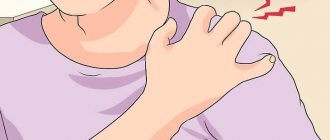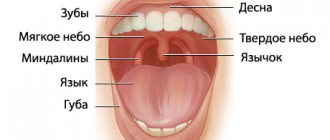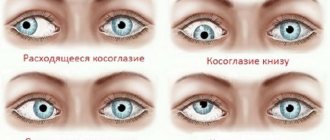Doctor:
Akhmedova Shani Vagifovna
Contrary to popular belief, a disorder such as astigmatism in children is very common. According to statistics, about 40% of children suffer from a mild form of this disease and another 6% have a severe form of astigmatism. The pathology brings a lot of inconvenience to children throughout their lives, negatively affects their success at school, and in the future threatens the development of myopia. For these reasons, it is extremely important to be able to recognize the problem and deal with it in a timely manner.
Astigmatism and its features
In simple terms, astigmatism is not a full-fledged disease. In fact, this term describes a refractive error affecting the structures of the visual organs. Features of the pathological condition include deformation of the lens and corneal layer of the eyes.
As a result of deformation of the mentioned structures, the refraction of light is disrupted. This leads to the fact that the image of objects in a person’s field of vision is not projected onto the retina, as in healthy people, but in the area in front of it or behind it. In practice, such an anomaly is expressed in the fact that a patient with astigmatism sees objects unclearly, their outline is blurred and blurred. The good news is that with today's level of medical development and knowledge of astigmatism, the pathology can be successfully treated.
This is interesting! Human physiology is designed in such a way that the prevailing percentage of children are already born with astigmatism, but in a mild form. By the first year of life, astigmatism decreases to 1 diopter. This form of impairment does not affect the quality of vision in any way and in medical practice is regarded as physiological astigmatism.
Therapy
Astigmatism is not a death sentence; refraction can be significantly improved using various methods. With a slight curvature of the corneal layer, simple exercises or wearing contact lenses will help. Laser correction of the corneal layer and lens is carried out only after 17-18 years, when the fundus of the eye is fully formed. Until this point, the child is prescribed contact lenses or special glasses with cylindrical lenses.
A distinctive feature of astigmatism is the lack of progression of the disease, so regular wearing of special optics can significantly correct the situation and control the pathology.
However, we should not forget that untreated astigmatism in a timely manner leads to other serious visual pathologies - lazy eye and strabismus. Therefore, the task of each parent is to comprehensively examine the baby not only with a pediatrician and orthopedist, but also with an ophthalmologist.
In difficult cases, surgery is performed to replace the natural lens with an artificial one. You should not be afraid of such operations; they are carried out using modern equipment with constant monitoring of the condition of the visual organs. After replacing the lens or leveling the corneal layer with a laser, vision is restored by almost 100%. There are complications, but in exceptional cases.
Spectacle correction
The use of special glasses restores clarity of visualization and relieves fatigue and pain in the visual organs. Wearing glasses also prevents headaches that accompany astigmatism. It is impossible to completely get rid of refractive pathology with the help of glasses, so most patients choose laser correction after the age of eighteen. The choice of laser correction is also due to the inconvenience of constant use of glasses, and some patients categorically cannot tolerate them for psychological reasons.
Note! Incorrectly selected optics contribute to the deterioration of visual functions.
Shy teenagers try to avoid wearing glasses due to emotional and psychological discomfort. Constant mental stress provokes headaches, discomfort in the eyes and the desire to get rid of glasses. In this case, contact lenses come to the rescue.
Contact optics
The lenses are invisible to the eyes and therefore do not cause psychological stress. Contact optics not only allow you to look aesthetically pleasing, but also provide complete freedom of movement. This is especially valuable for active teenagers.
Lenses have their drawbacks, but they do not relate to aesthetics and freedom of movement. Teenagers are willing to endure daily care for contact lenses and experience discomfort when putting on/removing lenses, just so as not to look inferior in the eyes of their peers.
However, lenses also have advantages over glasses: they provide full lateral vision. This allows a person to better navigate space and perceive the world in a three-dimensional image. Glasses cannot provide a full-fledged three-dimensional image of the world due to limitations in lateral vision.
Modern ophthalmology offers an innovative way to correct astigmatism using night lenses. They need to be worn only during night sleep; the lenses are removed in the morning. A specially designed rigid structure puts pressure on the corneal layer, leveling pathological defects. However, by evening the cornea takes on its natural shape, so the correction only works for a while. But this is enough to feel like a full-fledged person - without glasses and contacts. Rigid night lenses are used for corneal astigmatism.
The disadvantage of contact optics is the prohibition of wearing them during ARVI and conjunctivitis. Also, lenses cannot be used for certain infectious ophthalmological diseases in a chronic form. In this case, correction is carried out using special glasses.
Lenses for children
At what age can a child wear contact lenses? Ophthalmologists believe that after reaching 13-14 years of age, a child can purchase contact optics. If a child is characterized by increased responsibility at the age of 12, then he can already be trusted to wear contact lenses and care for them.
The use of lenses requires increased responsibility for visual hygiene, timely replacement of optics and compliance with the rules for storing/cleaning lenses. Young children do not realize that the use of lenses can damage the mucous membrane of the eyes when touched with their hands. A child can get dirt into their eyes if they rub them with unwashed hands.
During adolescence, children become more responsible, but they must be taught how to use contact products correctly. Until a teenager understands all the intricacies of using, cleaning and storing contact optics, adult supervision is necessary. You should not go to bed wearing daily lenses, as this will cause oxygen starvation (hypoxia) of the tissues of the visual apparatus. It is also prohibited to exceed the time of use of contact lenses and to replace them in a timely manner.
The teenager needs to be explained that when the mucous membrane of the eyes dries out, the use of moisturizing drops is required. This is necessary so that irritation of the mucous membrane does not develop into conjunctivitis. An adult child can independently administer eye drops, apply them as needed, and store them correctly. It is unlikely that it will be possible to agree on this with a younger child, so doctors prescribe glasses instead of lenses.
Laser correction
The operation is performed after the formation of the fundus. Until this moment, any invasive technique will not be successful: the eye is in the stage of formation and change of internal structures. To correct the corneal layer, the Lasik method is used - “evaporation” of the excess corneal layer. For lens astigmatism, an artificial lens is implanted.
When correcting the topography of the corneal layer, a laser beam is used to straighten the curved surface. No special preparation for the operation is required; the manipulation is performed under local anesthesia; no stitches are required after the operation. Rehabilitation after invasive intervention is quick, no complications are observed.
Who is indicated for artificial lens replacement? Ophthalmologists advise carrying out this procedure after 45 years, this is the most favorable time for a planned operation. It is not cost-effective to make a replacement earlier, but after the specified age it is not always justified. Artificial lenses are made from material that is biologically compatible with eye tissue. They perfectly replace the natural lens, which is the crystalline lens, and provide high-quality vision.
Gymnastics for the eyes
Astigmatism cannot be treated with exercises or wearing glasses/lenses. You can restore 100% vision only with the help of invasive correction methods. However, gymnastic exercises are a prevention of ophthalmological pathologies caused by incorrect refraction. Therefore, parents should pay special attention not only to the hygiene of the child’s visual organs, but also to the timely implementation of exercises to relieve tension from the visual apparatus.
Eye exercises:
- Movement of the eyes up and down and left and right with closed and open eyelids.
- Rotate your eyes clockwise, then counterclockwise.
- Look alternately at the tip of the finger of an outstretched hand, and then out the window at a distant object.
- Other exercises as recommended by an ophthalmologist.
After performing each exercise, it is recommended to blink at a fast pace for a minute or two.
In addition to exercises and regular relief of the visual apparatus from overstrain, vitamin nutrition is recommended. Blueberry berries/leaves in any form (fresh, frozen, dry), carrot juice, herbs, fresh fruits and vegetables are good for the eyes. A balanced diet and consumption of vitamin complexes will help strengthen the optical apparatus and reduce the likelihood of developing serious ophthalmological diseases.
Reasons for the development of astigmatism
Regarding the reasons for the development of the pathological process, the most likely and common factor in its development is genetic predisposition. Such astigmatism is congenital, it is caused by deformation of the lens or corneal layer of the eye at birth.
In ophthalmology there is the concept of acquired astigmatism, the main causes of which are:
- various mechanical damage to the ocular structures;
- consequences of severe forms of diseases of the dental system;
- subluxation of the lens.
Clinical picture
Identifying the symptoms of astigmatism in childhood is difficult, because for a long time the child is not able to talk about the problem or describe his complaints. Parents do not even suspect that their baby sees the world as blurry and blurry. For this reason, it is important to know a number of indirect signs that indicate a problem and allow you to detect it:
- frequent headaches, especially in the forehead;
- frequent dizziness;
- avoidance of reading and writing, whims on this basis; bowing the head in different directions when reading, writing, looking at pictures;
- constant squinting of the eyes when trying to look at small objects, text, etc.
Each of these signs indirectly indicates astigmatism, however, they do not 100% confirm the presence of pathology. Their identification is only a reason to consult a doctor for diagnosis.
To ensure that the child does not overload the organ of vision:
- Minimize (up to 3-4 hours a day) the time spent on the computer or other devices. You need to take breaks every 45 minutes. Buy anti-glare glasses for working at the computer with a filter against blue and violet rays;
- Provide good lighting in the house and especially at your desk and make sure that light sources do not flicker, create glare or interfere with vision;
- Teach children to wear UV-blocking sunglasses, especially in clear weather;
- Control the regime. The duration and quality of sleep are also very important for proper eye rest.
Classification of childhood astigmatism
In ophthalmological practice, there are several types of astigmatism in childhood. The classification depends on the characteristics of the onset and course of the disease, the degree of its progression and a number of other factors.
According to the nature of the course, astigmatism is classified as follows:
- physiological - visual impairment reaches no more than 1 diopter, which does not affect the clarity and acuity of vision, this type of pathology does not need correction;
- pathological - visual impairment exceeds 1 diopter, which negatively affects the clarity of everything a person sees; treatment is required.
Depending on the nature of the occurrence of disorders, the following types of astigmatism are distinguished:
- congenital - its occurrence is determined by genetics, occurs from infancy, but is detected more often during the period of life from 1 to 2 years;
- acquired – visual impairment occurs after exposure to external factors, such as injury.
Astigmatism is divided depending on the nature of the flow:
- corneal - the peculiarity of this type of astigmatism lies in the reason for its development, which is the deformation of the corneal layer of the eye. With this type of pathology, vision deteriorates more than if the problem were in the lens;
- lenticular – the cause of visual impairment lies in the deformation of the lens body;
- hyperthermic - a feature of this type of astigmatism is the development of farsightedness, while the image that the eye recognizes is projected behind the retina;
- myopic - unlike the previous type of pathological process, it is accompanied by the development of myopia.
According to the characteristics of damage to the organs of vision, the following types of astigmatism are distinguished:
- simple – characterized by the development of some type of astigmatism in one eye;
- complex – both organs of vision are affected equally;
- mixed - astigmatism also affects both eyes, but is expressed to varying degrees.
Ophthalmologists are guided by a gradation that takes into account the degree of vision impairment. Thus, weak astigmatism corresponds to a “drop” of vision up to 3 diopters, average – up to 6 and strong – over 6 diopters.
Why is astigmatism correction at the Sfera clinic the best option?
Many parents who monitor the eye health of their children regularly undergo examinations at the Sfera ophthalmology clinic. They choose us for many reasons:
- Our specialists have been certified according to the international standard of evidence-based medicine and work in accordance with it;
- Our clinic is a recognized leader in the implementation of the latest innovative technologies recognized throughout the world;
- We comply with the most stringent European standards and guarantee high quality diagnostics and treatment;
- We have a complex of modern unique equipment that allows us to effectively treat various pathologies in children.
You can make an appointment with our specialists in Moscow by filling out a simple form on our website or by calling +7.
Diagnostics
Diagnosing astigmatism is a complex process. Children with a congenital form of pathology (or acquired at different ages) are accustomed to seeing the world blurry. Young patients do not understand that they see blurredly, which is why they are not able to answer the doctor’s questions correctly.
For this reason, it is impossible to diagnose pathology without the involvement of an ophthalmologist. The diagnostic process itself consists of the following methods:
- use of an autorefractometer by an ophthalmologist;
- use of a cylindrical lens and a remote plate with numbers, letters, pictures;
- keratometry, which allows you to determine the degree of deformation of the meridians of the corneal layer;
- Computer topography is the most modern and accurate diagnostic method, which involves the use of special equipment.
Contact lenses
Starting at about 10 years of age, a child can already use toric contact lenses. Children often choose this type of correction. It is more convenient to engage in active recreation and play while wearing lenses, and this eliminates ridicule from peers, because many teenagers are embarrassed to wear glasses. It is important for parents to ensure that their child properly cares for optics and follows hygiene rules. It is best to choose daily lenses for the first wear.
Modern manufacturers produce toric lenses in a wide range. For example, the monthly replacement model SofLens 66 Toric from the manufacturer Bausch + Lomb has optimal characteristics. Also popular is the Air Optix for Astigmatism model from Alcon, which has the highest level of oxygen permeability of 138 units. These lenses provide eye comfort all day long.
Treatment
It is important to understand that the earlier a problem is detected, the easier it is to fix. In addition, early access to qualified help allows you to preserve your vision to a greater extent.
The main feature of the treatment of childhood astigmatism is that until adulthood, therapy consists exclusively of the use of conservative methods. After 18 years, the anatomical development and growth of the visual organs stops, which opens up broader prospects and opportunities for treatment.
Using glasses
The young patient is fitted with special glasses, which are equipped with lenses of a special cylindrical shape. This device allows you to correct the disorder and restore proper eye function, but limits lateral vision.
It is important to know that in the first 3-7 days, wearing glasses may cause tired eyes, discomfort and headaches. If these symptoms do not go away after a week, this indicates that the glasses were chosen incorrectly and you should immediately consult an ophthalmologist.
Using Lenses
Contact lenses for astigmatism are prescribed special ones - they have a rigid structure (they are called hard), due to which the correct shape of the corneal layer is gradually restored. Such therapeutic attributes are put on only before going to bed and are able to correct the pathology in the early stages of progression, until vision “falls” below 1.5 diopters.
Laser correction
The method belongs to the category of surgical treatment methods and is used only after 18 years. The procedure is painless and safe; it will take 15-20 minutes. Improvement in vision after it should be expected after 1-2 hours. After another 5-7 days, clarity and visual acuity will be fully restored.
The advantages of laser correction are undeniable:
- complete restoration of vision;
- absence of stitches and other traces of traditional surgery;
- no need for rehabilitation.
Correction with astigmatic glasses
The most common and generally the only method of correction is up to the age of 9-10 years (starting from this age, contact lenses can become an alternative to glasses). To correct astigmatism, you need special lenses that have a complex design and are called cylindrical. They make it possible to correct the difference in refraction of the two main meridians of the eye. Their main feature is the axis, which has no optical effect. In the opposite direction from it there is a focus, due to which the lens has the same effect as a spherical one. Optics with cylindrical lenses are prescribed for refractive error in a separate meridian. If the astigmatism is mixed, then toric lenses are needed - a clearly calculated combination of cylindrical lenses with spherical ones. They refract the light flux along two meridians at once.
When wearing glasses to correct astigmatism, you need to visit a doctor at least once every six months so that he can check what changes have occurred in the eyes during this time and, if necessary, write out a different prescription for glasses, for example, with smaller diopters.
Prevention
Astigmatism is a disease whose progression can be slowed down, and in some cases (in the case of acquired astigmatism) prevented. To do this, follow the following recommendations:
- reading and other eye strain are permissible only when the room is fully illuminated;
- do not use fluorescent lamps;
- dose visual stress, give your eyes a rest; do eye exercises (blinking, rotating your eyes, alternately looking into the distance and near);
- Massage your eyelids using light rotational movements with your fingertips with your eyes closed.











